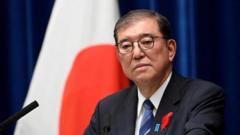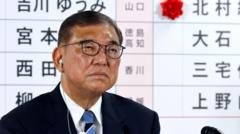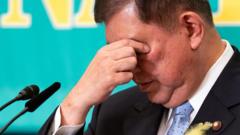Japanese voters took to the polls on Sunday in a nail-biting election that seeks to assess the popularity of Prime Minister Shigeru Ishiba's government. The ruling Liberal Democratic Party (LDP) and its coalition ally, Komeito, aim to secure at least 50 seats to maintain their majority in the upper house. However, new surveys indicate that their chances are dwindling. Economic challenges loom large, primarily due to tensions with the United States over trade tariffs, led by President Donald Trump, which adds pressure on Japan's significant auto sector. This sector is already suffering from imposed tariffs that threaten jobs constituting approximately eight percent of the nation's workforce.
Japan's Elections Pose Major Challenge for PM Shigeru Ishiba Amid Economic Strain

Japan's Elections Pose Major Challenge for PM Shigeru Ishiba Amid Economic Strain
As Japanese voters prepare to cast their ballots, Prime Minister Shigeru Ishiba faces a critical test of political endurance against a backdrop of economic turmoil and rising public dissatisfaction.
In recent weeks, Japan has seen alarming economic indicators, including weak export data that suggest a potential slide into technical recession. The public's concern is heightened by the sharp increase in the cost of everyday essentials like rice, which has nearly doubled over the past year. The government has been forced to tap into its emergency stockpiles, as affordability continues to slip for many households. The sluggish wages coupled with persistent inflation have led to waning trust in Ishiba's leadership following a disappointing performance in last year's lower house election.
Meanwhile, the populist Sanseito party has gained traction by appealing to younger voters through social media, capturing attention with its "Japanese First" campaign. This party's hardline stance towards immigration and globalism, along with their takes on gender policies and environmental strategies, has resonated with a section of the electorate, even as it garners criticism for its strict approaches.
Should Ishiba's coalition fail to secure the necessary seats, it risks losing its majority in both chambers of parliament, which could jeopardize his leadership and usher in instability. The LDP, which has typically held power since 1955 interspersed with leader changes, last faced such an electoral setback in 2010, leading to a significant political shift. As the polls close, all eyes are on the results and their implications for Japan’s immediate political landscape.
Meanwhile, the populist Sanseito party has gained traction by appealing to younger voters through social media, capturing attention with its "Japanese First" campaign. This party's hardline stance towards immigration and globalism, along with their takes on gender policies and environmental strategies, has resonated with a section of the electorate, even as it garners criticism for its strict approaches.
Should Ishiba's coalition fail to secure the necessary seats, it risks losing its majority in both chambers of parliament, which could jeopardize his leadership and usher in instability. The LDP, which has typically held power since 1955 interspersed with leader changes, last faced such an electoral setback in 2010, leading to a significant political shift. As the polls close, all eyes are on the results and their implications for Japan’s immediate political landscape.






















